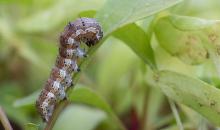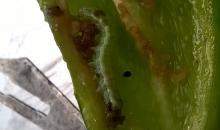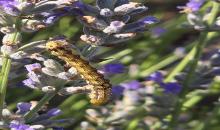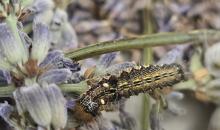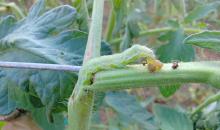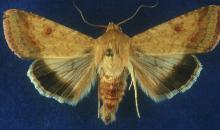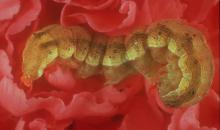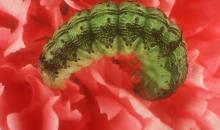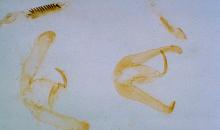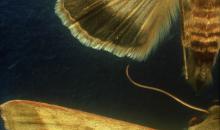Helicoverpa armigera(HELIAR)
Photos
For publication in journals, books or magazines, permission should be obtained from the original photographers with a copy to EPPO.
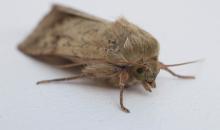
Adult - photographed at the Department of Entomology, University of Sao Paulo, Brazil
Courtesy: Regina Sugayama
Adult - photographed at the Department of Entomology, University of Sao Paulo, Brazil
Courtesy: Regina Sugayama
Adult - photographed at the Department of Entomology, University of Sao Paulo, Brazil
Courtesy: Regina Sugayama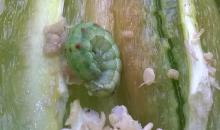
Last larval stage in capsicum fruit from Tunisia
Courtesy: Pascal Reynaud. BIP of Marseille seaport (FR)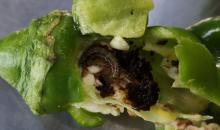
Young larva in capsicum fruit from Tunisia
Courtesy: Jean Michel Mei, Pascal Reynaud. BIP of Marseille seaport (FR)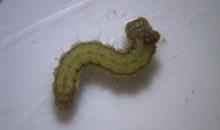
Larva of Helicoverpa armigera collected on Solanum aethiopicum from Senegal
Courtesy: Anne-Hélène Sirvent - BCP Roissy CDG Airport (FR)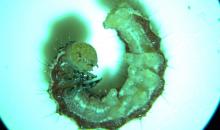
Collected from Abelmoschus esculentus from Senegal
Courtesy: Simone Formery - Point of Entry Roissy CDG airport (FR)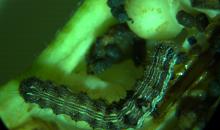
Collected from Abelmoschus esculentus from Senegal
Courtesy: Simone Formery - Point of Entry Roissy CDG airport (FR)
Collected from Abelmoschus esculentus from Senegal
Courtesy: Simone Formery - Point of Entry Roissy CDG airport (FR)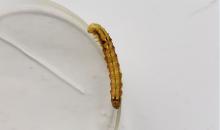
Helicoverpa armigera found on eggplant (Solanum aethiopicum) from Senegal
Courtesy: Antoine Gabriele - BCP Roissy CDG Airport (FR)
Collected from Abelmoschus esculentus from Senegal
Courtesy: Simone Formery and Blandine Delbourse - Point of Entry Roissy CDG airport (FR)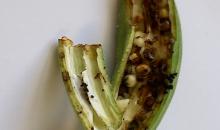
Damage in Abelmoschus esculentus imported from Senegal
Courtesy: Simone Formery and Blandine Delbourse - Point of Entry Roissy CDG airport (FR)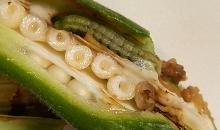
Larva of Helicoverpa armigera collected on Abelmoschus esculentus from Senegal
Courtesy: Blandine Delbourse - Point of Entry Roissy CDG airport (FR)
Larva of Helicoverpa armigera collected on Abelmoschus esculentus from Senegal
Courtesy: Blandine Delbourse - Point of Entry Roissy CDG airport (FR)
Larva of Helicoverpa armigera collected on Abelmoschus esculentus from Senegal
Courtesy: Blandine Delbourse - Point of Entry Roissy CDG airport (FR)
Larva of Helicoverpa armigera collected on Abelmoschus esculentus from Senegal
Courtesy: Blandine Delbourse - Point of Entry Roissy CDG airport (FR)
Larva of Helicoverpa armigera collected on Abelmoschus esculentus from Senegal
Courtesy: Blandine Delbourse - Point of Entry Roissy CDG airport (FR)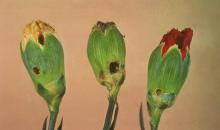
Carnation flower heads damaged by H. armigera, showing petals eaten away and entry holes of larvae.
Courtesy: Central Science Laboratory, York (GB) - British Crown.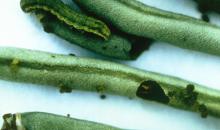
French beans attacked by Helicoverpa armigera. Note the larvae within the bean.
Courtesy: SRPV, Ile de France (FR).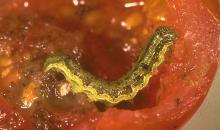
Larva of H. armigera in tomato fruit.
Courtesy: Central Science Laboratory, York (GB) - British Crown.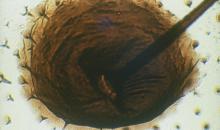
Differentiation of larva by the form of thorns on larval skin: larval skin of H. armigera (13th body segment).
Courtesy: W. Billen - Pflanzenbeschaustelle, Weil am Rhein (DE).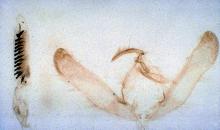
Genital organs (male) of H. armigera (female genital organs are not suitable for exact determination).
Courtesy: W. Billen - Pflanzenbeschaustelle, Weil am Rhein (DE).


